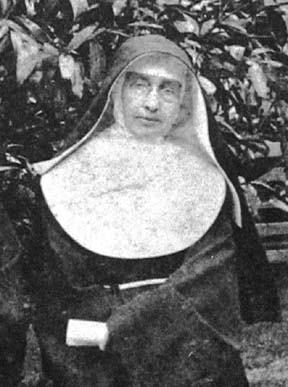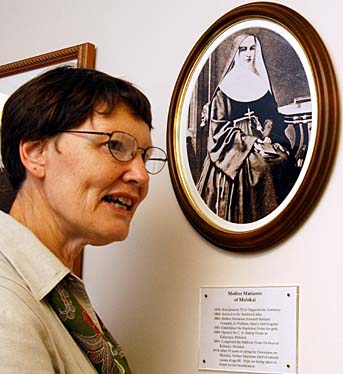
ASSOCIATED PRESS
Mother Marianne Cope: She stayed for 30 years after first volunteering to help Molokai
Canonization is pushed
for Molokai's other saintMother Marianne Cope is not
as well known but sacrificed
as much as Father Damien
A Roman Catholic nun whose ministry to Kalaupapa's leprosy patients on Molokai lasted twice as long as Father Damien's may take her first step toward sainthood.
Mother Marianne Cope, who garners just a fraction of the attention given the Belgian priest who died in 1889, is on a Vatican waiting list for a hearing on her canonization cause -- an inquiry that could lead to her designation as "venerable."
News of that progress in Rome comes as the Vatican's Congregation for the Causes of Saints reviews a miracle attributed to Father Damien de Veuster -- an unexplained healing that, if verified, could make the Belgian missionary a saint.
Father Damien died of leprosy, now called Hansen's disease, after 16 years in Kalaupapa and earned the devotion of masses worldwide. Mother Marianne and a layman known as Brother Joseph Dutton worked by Damien's side for a time and continued his work for decades after his death, but never achieved the same level of recognition for their work.
Dutton served longest of all -- 44 years -- but is not a candidate for sainthood.
"In the work for the lepers, Father Damien did nothing that Mother Marianne did not do likewise," the Rev. Peter Gumpel, the Vatican-appointed judge examining the sainthood case, said in his report to the Congregation for the Causes of Saints. She performed "with boundless energy the most humble, repulsive and dangerous services."
Mother Marianne, born Barbara Koob in Germany in 1838, took the name Marianne in 1862 when she joined the Sisters of the Third Order of St. Francis in New York.
ASSOCIATED PRESS
St. Francis Medical Center's mission educator, Sister Norise Kaiser, stands next to a picture of Mother Marianne Cope in Honolulu. Mother Marianne came to Molokai in 1883 with six Franciscan sisters to care for those suffering the devastating effects of Hansen's disease.
When the Kingdom of Hawaii sought help caring for leprosy patients at the Kakaako Branch Hospital in 1883, Mother Marianne and six other sisters volunteered to go to Honolulu.
"We were not only willing, but anxious to go and care for the poor outcasts," Cope wrote.
Five years later, when she was asked to supervise a new home for girls in Kalaupapa, she accepted and moved to the isolated peninsula on Molokai.
She was known for brightening the otherwise dismal days of her young patients, sewing them clothes, taking them on picnics, planting trees and flowers, and playing piano as they sang.
Mother Marianne eventually took over Kalaupapa's home for boys, too. In all she stayed for 30 years, until she died in 1918 at 80.
"It's not known, the tremendous sacrifice that Mother Marianne made," said Sister Mary Laurence Hanley, director of Cope's canonization cause at the headquarters for the St. Francis Sisters in Syracuse, N.Y. "The work would not have continued without her at Kalaupapa, that's for sure," said Hanley, co-author of "Pilgrimage and Exile: Mother Marianne of Molokai."
In Kalaupapa the Rev. Joseph Hendriks, pastor of the tiny St. Francis Church, where Mother Marianne's funeral was held, agreed.
"The need was so strong it was amazing," said Hendriks, also the founder of the Father Damien Museum in Waikiki. "Her faith and her character were strong enough that she said, 'I'll stay here.'"
Sister Norise Kaiser, a member of the Sisters of St. Francis, said recognizing Cope would be especially meaningful to women.
"She was a woman really representing women, coming into difficult situations and fighting against the odds in a unique way," said Kaiser, a mission educator at Honolulu's St. Francis Hospital, which Mother Marianne's order founded after her death.
Sister Olivia Gibson, who also works at St. Francis Hospital, became a nun in Marianne's order 60 years ago.
"I was all set to enter another order, but when I started reading Mother Marianne's story, I said, 'That's it, that's where I'm going.'"
Hanley has overseen the push for Mother Marianne's sainthood since it was formally launched in 1983. The Congregation for the Causes of Saints has had Gumpel's report on the nun's life since 1995.
Two years ago a Diocese of Syracuse tribunal completed its inquiry into an alleged miracle attributed to Mother Marianne: a girl's unexplained recovery from multiple organ failure.
Once there is movement in Mother Marianne's case in Rome, and she earns the title "venerable," Hanley said the potential miracle will be introduced to the Congregation for the Causes of Saints. If it is validated, it could mean beatification. Another verified miracle could earn Mother Marianne sainthood.
Still, sainthood for Marianne does not appear near. Unlike high-profile candidates like Mother Teresa -- who will be beatified this October, just six years after her death -- Mother Marianne does not appear to be a Vatican priority.
"It could be at the end of this year, it could be next year," Gumpel said of a hearing date within the Causes of Saints, in a telephone interview from the Vatican. "They are bound to discuss it. It's only a question of when."
During her life, Mother Marianne was honored with royal decorations by King Kalakaua and in poetry by Robert Louis Stevenson. Today, at St. Francis Sisters' convents in Hawaii and elsewhere, there are daily prayers that Mother Marianne will soon be recognized anew.
"Royalty and the simplest living persons she met spoke of how she excelled in how to live life selflessly for God and for neighbor and do it with the right spirit," said Hanley. "Her life exemplifies the spirit in which sacrifice can be given."

